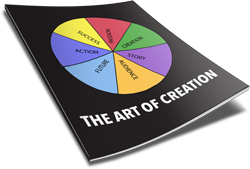Marsha had a great idea for a business. She dreamed about it every night, thought about it incessantly every day. She bought the domain name and chose a lovely shade of green for her logo.
Weeks went by. Then months. And Marsha began to lose enthusiasm for her project. WordPress themes. Graphics. Actual words. Opt-ins. Newsletters. Analytics. They danced through her head like high-strung Sugar Plum Fairies. What started off as “this is going to change the world” morphed into “I’m sooooooo overwhelmed.” Her idea stayed just that… an idea, tucked away safely in a Moleskine journal. In a box. In her garage.
Don’t be a Marsha.
The tasks involved in creating a website should never prevent you from putting your awesome thing out into the world. It all begins with a plan.
WHY PLANNING MATTERS
You wouldn’t build a sailboat without first drawing up some kind of plan. “This goes here. That goes there.” Follow the instructions and eventually you havea boat. AN ACTUAL BOAT! Heck, even Ikea provides a manual for putting together a side table. Four legs and a top seems pretty straightforward, but we still refer to the instructions to make sure we’re doing it right.
The same is true for a website. You need a plan, an instruction manual.
I’ve noticed that people tend to view website creation as a finished masterpiece rather than a work in progress. “Look at Davey Dinkleshort’s website. It’s so shiny and savvy.” They become frustrated by how much work they think it takes to make it all come together like Dinkleshort. What they don’t know is that Mr. D’s current website has been reinvented 12 times.
So… where should you start? Instead of choosing some random element and cobbling everything together so that it “kinda-sorta fits,” I recommend working through two big questions first.
- What do I want my website to do?
You think the answer would be as simple as “make me lots of money.” While a fistful of dollars can be freaking fantastic, the answer is a bit more complex than that. Do you want to build an email list? Sell products directly? Educate potential clients?
How you answer this question will determine the direction of your website.
- Who is my audience?
Please don’t say, “Everyone!” This is the wrongest of all wrong answers. Your audience should be a specific person with specific needs.
What is the pressing problem they want to fix right now? How do you solve it for them? Is your audience tech-savvy? Or do you need to keep things uber-simple?
Over the years, I’ve consoled dozens of clients who’ve struggled with their websites. I knew that I needed to create something that would help take away the pain of website overwhelm and break the process down into bite-sized, digestible chunks.
So I designed a Website Planner, an interactive tool that helps people design the look feel, and tone of their website while keeping ALL THE THINGS organized.
It’s yours and it’s free. Seriously. Sign up here to download it:
I believe that with the help of this guide (and some quality butt-in-the-chair time), your website will come together swimmingly.
If you’re ready to kick your business up a notch, check out my new 35-day course, The Art of Creation. Together we dive deep into creating your brand identity and build a strong foundation for your business.
 At the end of the day, the most important thing you can do for your brand is put it out into the world. Keeping it hidden away until it’s absolutely perfect means no one will benefit from your awesome thing. Lives won’t be changed.
At the end of the day, the most important thing you can do for your brand is put it out into the world. Keeping it hidden away until it’s absolutely perfect means no one will benefit from your awesome thing. Lives won’t be changed.
So start today. I’ve got your back.
